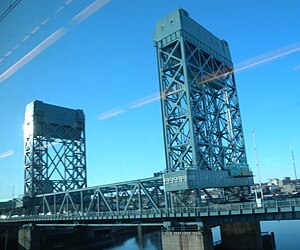Stickel Bridge
| William A. Stickel Memorial Bridge | |
|---|---|
 |
|
| Carries |
|
| Crosses | Passaic River |
| Locale | Newark and Harrison, New Jersey |
| Owner | New Jersey Department of Transportation |
| ID number | 0731161 |
| Characteristics | |
| Design | Vertical-lift Truss |
| Material | Steel |
| Total length | 687.6 feet (209.6 meters) |
| History | |
| Inaugurated | May 1, 1949 |
| References | |
The William A. Stickel Memorial Bridge is a vertical-lift bridge in New Jersey that crosses the Passaic River, connecting Newark and Harrison as part of Interstate 280. The bridge is named in honor of William A. Stickel, a civil engineer from Newark who served as the Essex County engineer for over 20 years.
The bridge was constructed from 1948 to 1949 as Route 25A and is owned and operated by the New Jersey Department of Transportation. The total length of the structure is 209.6 m, and it provides a clearance of 11.7 - 15.1 m. The length of the movable section is 41.9 m. The bridge was inaugurated on May 1, 1949 and became part of the interstate system in 1971.
The bridge is one of the few movable bridges that remain in the Interstate Highway System. The bridge remained manned by a drawtender until March 3, 1999. It rarely opens and requires 24-hour notice to NJDOT for opening. The six-lane Stickel Bridge has four through-traffic lanes and two lanes for traffic entering and exiting Route 21 at Exit 15 just west of the bridge.
The April 2001 release of a New Jersey Department of Transportation report labeling the Stickel Bridge "structurally deficient and functionally obsolete" has prompted officials to consider options to either rehabilitate or replace the bridge. Inspectors found both the superstructure and substructure of the old span to be in "poor" condition, the result of wall cracks and severe corrosion of structural steel. Furthermore, the steel-grated roadway, narrow lanes and tight ramps leading to the local streets have contributed to the bridge's high accident rate. As an interim measure, the NJDOT has reduced the speed limit on the bridge to 40 mph (64 km/h).
In May 2008, the rehabilitation work on the span was completed. Work included having its mechanical systems overhauled, and removal of its old black coating, in favor of a light blue paint.
...
Wikipedia
